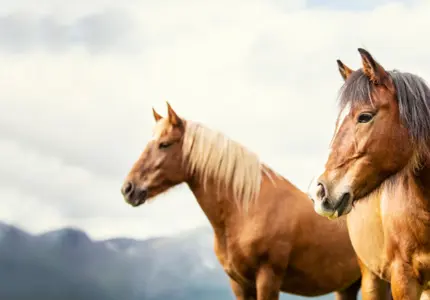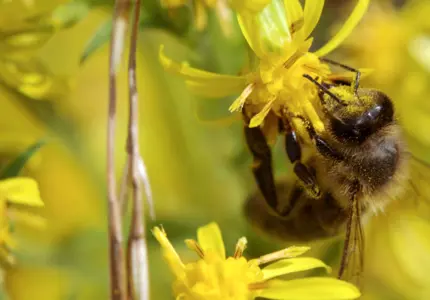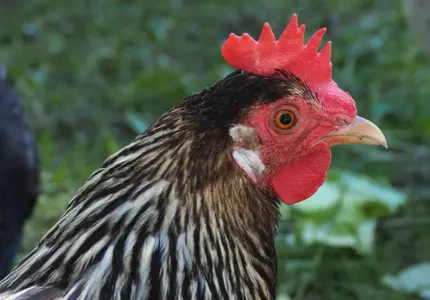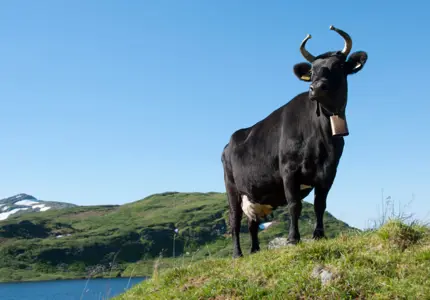
Nordic native breeds
There are more than 160 native Nordic farm animal breeds. At this site you can read more about some of them.
- Home
- Our work
- Farm animals
- Nordic native breeds
-
Nordland/Lyngen Horse
The first known and documented exhibition where this breed participated, was in 1898 at Lyngseidet in Troms. In the 1930s, organized breeding of Nordland/Lyngen horses started.
-
The Nordic brown bee
Honey bees are threatened by intensive agriculture, habitat loss and climate changes worldwide and are important to conserve, not only due to their honey production but also due to their pollination services.
-
Finnish Landrace Chicken
In 1974, the agricultural advisory agency collaborated with Seiskari and published a call to find remains of the Finnish landrace chicken. As a result, one flock was found in South-East Finland. This family line was named after its geographical location as “Savitaipaleenkanta”.
-
Dola Cattle
The Dola cattle originates from Gudbrandsdalen, Østerdalen and Hedmarken, areas north of Oslo. In these areas there were large areas for nutrient-rich grazing, but it was too far to larger cities for the sale of dairy products.
-
Jutland Cattle
Jutland Cattle is one of the oldest cattle breeds in Denmark. As implied by the name, the breed origins from a variegated type of cattle widespread across Jutland, Denmark, from the 17th to the 20th century.
-
Icelandic Horse
The Icelandic horse breed has developed from ponies taken to Iceland by Norse settlers in the 9th and 10th centuries.
-
Itäsuomenkarja (ISK)
The Eastern Finncattle (EFC), as the name implies, is traced to the eastern part of Finland. It is the oldest Finncattle breed.
-
Danish Black and White Cattle
The breed is known under multiple names and originates from Jutland cattle.
-
Zemaitukas
Since the 19th century, the Zemaitukas horses were used as a labour source in agriculture, as a means of transport, and objects for export.
-
Norwegian Fjord Horse
The Fjord horse is the Norwegian national horse breed that has the largest populations outside Norway’s borders in Denmark, Sweden, Belgium, the Netherlands, Germany and the USA.
-
Swedish Mountain Cattle
The Swedish Mountain Cattle of today descends from the landrace of eastern origin that has been kept in the northern parts of the Nordic countries for at least 1,000 years.
-
Dole horse
The Dole horse originated in Gudbrandsdalen and Eastern Norway in general. The breed was established in 1857 and arose in the middle of the 19th century when the need arose to breed a horse especially suitable for work in agriculture and forestry and for the transport system.
-
Finnhorse
The oldest single horse bone found in Finland is dated to the Bronze Age. According to the latest research, the earliest family roots of the Finnhorse are directed to the east.
-
Swedish Cold-blooded Trotter
The Swedish cold-blodded trotter is a descendandt of the Nordic Landrace Horse, with its origins sometime 2000-3000 years before Christ, the Swedish Cold-blooded Trotter is probably the oldest trotting breed in the world.
-
The Faroese Horse
Brought to the Faroe Islands by Norse settlers in the 9th and 10th centuries, the geographical remoteness in the North Atlantic Ocean forced these horses to adapt to its surroundings.
-
Frederiksborg Horse
The Frederiksborg horse was founded in the 16th century by the Danish kings Frederik II and Christian IV, who gathered the best horse material from the European royal stud farms of the time.
-
Agersoe Cattle
In the 1990’s a herd of different looking cattle was discovered on the Danish island Agersø, located between Sealand and Funen.
-
Coloursided Troender and Nordland Cattle (STN)
The breed is mainly a dairy breed, adapted to the conditions in valley and mountain settlements in Norway. STN has its background in the central and northern areas of Norway.
-
Faroese Cattle
The first settlers came to Faroe Islands 12-1500 years ago. The cattle population was kept isolated on the islands in the following hundreds of years.
-
Íslenskir nautgripir
The origin of the Icelandic cattle can be traced back to the settlement of Iceland in the 9th century by Norse migrants. Research has shown that the breed is related to the native breeds in Scandinavia.
-
Pohjoissuomenkarja (PSK)
The Northern Finncattle (NFC) is also called Lapland cow. In 2019, 338 of the cows in the Faba Coop’s dairy monitoring system were Northern Finncattle, and the breed is classified as endangered.
-
Western Finncattle
Three local Finnish native cattle breeds are known as Finncattle: The Eastern (ISK), Western (LSK) and Northern Finncattle (PSK).
-
Norwegian Coldblooded Trotter
Norwegian coldblooded trotter is a hardy, versatile and strong horse breed that has a common origin with the Norwegian Dole horse. Over time, the coldblooded trotter has been refined into a lighter breed to improve both its speed and agility, and its main area of use is harness racing.
-
North Swedish horse
The North Swedish horse derives from local horses in the Swedish mainland, and is described as a dependable, calm and durable breed. The breed was established in the 20th century, while its breeding association was founded in 1924. The breed’s ancestor had had a long history as a human companion: The horse has been illustrated both as a riding horse and draft horse in the petroglyphs from the Bronze Age.
-
Gotland Pony
The Gotland pony is one of the oldest horse breeds in Europe and is the only pony breed native to Sweden. As the name suggests, the breed originated from the Gotland island, where the horses at first lived more or less in the wild.
-
Swedish Ardennes
The first Ardennes stallions were imported to Sweden by Count C. G: Wrangel in 1873, these were followed by a pair of mares in 1874. The horses came from south-eastern Belgium, which is considered the origin of the Ardennes horse.
-
The Faroese sheep
The Faroe Islands are home to a single native sheep breed - Føroyskur seyður (the Faroese sheep). Today, sheep still play a vital role in Faroese society, outnumbering humans on the islands: approximately 70, 000 sheep to 54, 000 people .
-
Finnish sheep breeds
The Finnsheep originates from animals in eastern Finland that were valued for their desirable size. Today it is the most common sheep breed in the country, and the breed is especially popular for its high fecundity, a characteristic that has attracted global interest; Finnsheep have been exported to more than 40 countries.


























